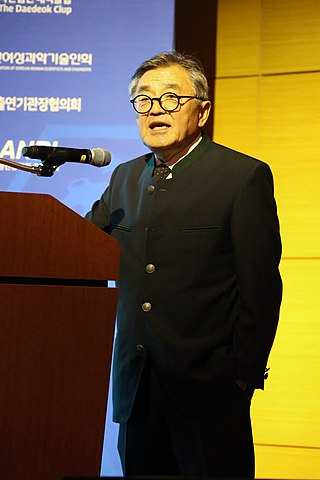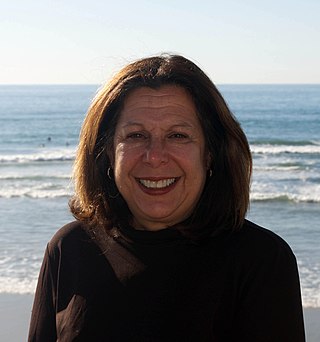Related Research Articles

Environmental engineering is a professional engineering discipline related to environmental science. It encompasses broad scientific topics like chemistry, biology, ecology, geology, hydraulics, hydrology, microbiology, and mathematics to create solutions that will protect and also improve the health of living organisms and improve the quality of the environment. Environmental engineering is a sub-discipline of civil engineering and chemical engineering. While on the part of civil engineering, the Environmental Engineering is focused mainly on Sanitary Engineering.

Atmospheric chemistry is a branch of atmospheric science in which the chemistry of the Earth's atmosphere and that of other planets is studied. It is a multidisciplinary approach of research and draws on environmental chemistry, physics, meteorology, computer modeling, oceanography, geology and volcanology and other disciplines. Research is increasingly connected with other areas of study such as climatology.
The American Institute of Chemical Engineers (AIChE) is a professional organization for chemical engineers. AIChE was actually established in 1908 to distinguish chemical engineers as a profession independent of chemists and mechanical engineers.

Atmospheric dispersion modeling is the mathematical simulation of how air pollutants disperse in the ambient atmosphere. It is performed with computer programs that include algorithms to solve the mathematical equations that govern the pollutant dispersion. The dispersion models are used to estimate the downwind ambient concentration of air pollutants or toxins emitted from sources such as industrial plants, vehicular traffic or accidental chemical releases. They can also be used to predict future concentrations under specific scenarios. Therefore, they are the dominant type of model used in air quality policy making. They are most useful for pollutants that are dispersed over large distances and that may react in the atmosphere. For pollutants that have a very high spatio-temporal variability and for epidemiological studies statistical land-use regression models are also used.
Pratim Biswas is currently the Dean of Engineering, University of Miami, since January 2021. He was the Lucy and Stanley Lopata Professor of Environmental Engineering Science, Asst. Vice Chancellor for International Programs, and Chair of the Department of Energy, Environmental and Chemical Engineering at Washington University in St. Louis. He is also Director of MAGEEP, the McDonnell Academy Global Energy and Environmental Partnership. He received his doctoral degree from the California Institute of Technology, Pasadena in 1985, and his bachelor's degree in Mechanical Engineering from the Indian Institute of Technology, Bombay in 1980. He was elected to the United States National Academy of Engineering in 2019 "for advancing the science of aerosol dynamics and particle removal technologies."
A chemical transport model (CTM) is a type of computer numerical model which typically simulates atmospheric chemistry and may give air pollution forecasting.
Edwin Niblock Lightfoot, Jr. was an American chemical engineer and Hilldale Professor Emeritus in the Department of Chemical and Biological Engineering at the University of Wisconsin-Madison. He is known for his research in transport phenomena, including biological mass-transfer processes, mass-transport reaction modeling, and separations processes. He, along with R. Byron Bird and Warren E. Stewart, co-authored the classic textbook Transport Phenomena. In 1974 Lightfoot wrote Transport Phenomena and Living Systems: Biomedical Aspects of Momentum and Mass Transport. He was the recipient of the 2004 National Medal of Science in Engineering Sciences.

Kil-Choo Moon is a leading Korean engineer and environmental scientist and President of the International Union of Air Pollution Prevention and Environmental Protection Associations (IUAPPA). He has served as President of the Korea Institute of Science and Technology and of the Korea University of Science and Technology and a Distinguished Professor of Korea University.
Howard Brenner was a professor emeritus of chemical engineering at Massachusetts Institute of Technology. His research profoundly influenced the field of fluid dynamics, and his research contribution to fundamental principles of fluid dynamics has been deeply honored. His first textbook, Low Reynolds Number Hydrodynamics, earned him a reputation lasting several decades. His profession though fundamental research is on microfluidics, complex liquids, interfacial transport process, emulsion rheology, and multiphase flows.

Vicki H. Grassian is a Distinguished Professor in the Department of Chemistry and Biochemistry at the University of California, San Diego. She also holds the Distinguished Chair in Physical Chemistry.
Kimberly A. Prather is an American atmospheric chemist. She is a Distinguished Chair in Atmospheric Chemistry and a Distinguished Professor at the Scripps Institution of Oceanography and Department of Chemistry and Biochemistry at UC San Diego. Her work focuses on how humans are influencing the atmosphere and climate. In 2019, she was elected a member of the National Academy of Engineering for technologies that transformed understanding of aerosols and their impacts on air quality, climate, and human health. In 2020, she was elected as a member of the National Academy of Sciences. She is also an elected Fellow of the American Philosophical Society, American Geophysical Union, the American Association for the Advancement of Science, American Philosophical Society, and the American Academy of Arts and Sciences.
Sonia Maria Kreidenweis is an American Professor of Atmospheric Sciences at Colorado State University. Her research considers aerosols and their impact on weather and the climate. She has previously served as President of the American Association for Aerosol Research and was a board member of the American Meteorological Society. She was elected a Fellow of the American Geophysical Union in 2019.
Lynn Russell is a professor of atmospheric chemistry at the Scripps Institute of Oceanography a division of the University of California, San Diego in La Jolla, California.

Linsey Chen Marr is an American scientist who is the Charles P. Lunsford Professor of Civil and Environmental Engineering at Virginia Tech. Her research considers the interaction of nanomaterials and viruses with the atmosphere. During the COVID-19 pandemic Marr studied how SARS-CoV-2 and other airborne pathogens could be transported in air. In 2023, she was elected to the National Academy of Engineering.
JoAnn Slama Lighty is an American chemical engineer who is a professor at Boise State University. Her research considers carbon capture, chemical looping and black carbon emissions. In 2020 she was elected a Fellow of the American Association for the Advancement of Science for her air quality research.
Barbara Jo Turpin is an American chemist who is a Professor of Atmospheric Chemistry at the University of North Carolina at Chapel Hill. Her research considers aerosol science and environmental engineering. Turpin studies the formation of organic particulate matter via aqueous chemistry. She was awarded the 2018 American Chemical Society Award for Creative Advances in Environmental Science and Technology. Turpin is a Fellow of the American Association for Aerosol Research, American Geophysical Union and American Association for the Advancement of Science.
José Luis Jiménez-Palacios is a Spanish–American chemist and engineer. As a professor of Chemistry at the University of Colorado Boulder, Jimenez contributed to the establishment of the Aerodyne Aerosol Mass Spectrometer, an instrument for real-time analysis of aerosol size and composition.
Vivian Faye McNeill is an American atmospheric chemist who is Professor of Chemical Engineering at Columbia University. She leads the University's initiative Clean Air Toolbox for Cities. McNeill provided expert guidance on aerosols and ventilation throughout the COVID-19 pandemic.
Colin Dermot O'Dowd is an Irish physicist and atmospheric scientist.
References
- 1 2 "John H. Seinfeld | Division of Chemistry and Chemical Engineering". www.cce.caltech.edu. Retrieved 2020-05-28.
- 1 2 3 "Distinguished Alumni: John Seinfeld". hajim.rochester.edu. University of Rochester. Retrieved 21 April 2022.
- ↑ Seinfeld, John H. (1967). Optimal control of distributed-parameter systems.
- ↑ Unnamed (1994). "John H. Seinfeld of the California Institute of Technology". Chemical Engineering Education. 28 (2): 83. Retrieved 21 April 2022.
- ↑ Unnamed (1994). "John H. Seinfeld of the California Institute of Technology". Chemical Engineering Education. 28 (2): 84. Retrieved 21 April 2022.
- 1 2 3 "2012 Tyler Laureates". tylerprize.org. Tyler Prize for Environmental Achievement. Retrieved 21 April 2022.
- 1 2 "John H. Seinfeld". ccst.us. California Council on Science and Technology. Retrieved 21 April 2022.
- ↑ "Winners: Allan P. Colburn Award for Excellence in Publications by a Young Member of the Institute". aiche.org. American Institute of Chemical Engineers. Retrieved 21 April 2022.
- ↑ "Award recipients" (PDF). searchpub.nssc.nasa.gov. National Aeronautics and Space Administration. Retrieved 21 April 2022.
- ↑ "Dr. John H. Seinfeld". NAE Website. Retrieved 26 July 2021.
- ↑ "Winners: William H. Walker Award for Excellence in Contributions to Chemical Engineering Literature". aiche.org. American Institute of Chemical Engineers. Retrieved 21 April 2022.
- ↑ "Joe Garcia, an assistant principal at El..." Los Angeles Times. June 11, 1987. Retrieved 21 April 2022.
- ↑ "Dr. John H. Seinfeld". amacad.org. American Academy of Arts and Sciences. Retrieved 21 April 2022.
- ↑ "ACS Award for Creative Advances in Environmental Science and Technology Recipients". acs.org. American Chemical Society. Retrieved 21 April 2022.
- ↑ "Fuchs Memorial Award 1998". Aerosol Science and Technology. 31 (1): 1–2. 1999. Bibcode:1999AerST..31....1.. doi:10.1080/02786829909595088 . Retrieved 21 April 2022.
- ↑ Ayers, Tiffany (1999). "AAAS Members Elected as Fellows". Science. 286 (5441): 978. Retrieved 21 April 2022.
- ↑ "Winners: Warren K. Lewis Award for Chemical Engineering Education". aiche.org. American Institute of Chemical Engineers. Retrieved 21 April 2022.
- ↑ "Nevada Medal". dri.edu. Desert Research Institute. Retrieved 21 April 2022.
- ↑ "Five to Receive Honorary Degrees at Commencement, Sunday, May 19". cmu.edu. Carnegie Mellon University. Retrieved 21 April 2022.
- ↑ "Haagen-Smit Award Recipients | California Air Resources Board". ww2.arb.ca.gov. Retrieved 2022-09-23.
- ↑ "Aurel Stodola Lecture". mavt.ethz.ch. ETH Zurich. Retrieved 21 April 2022.
- ↑ "Past Honorary Degree Recipients". clarkson.edu. Clarkson University. Retrieved 21 April 2022.
- ↑ "John H. Seinfeld". nasonline.org. National Academy of Sciences. Retrieved 21 April 2022.